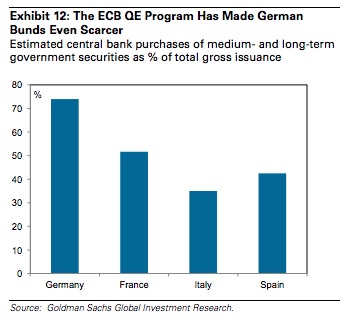Last week, we witnessed a rather dramatic sell-off in German Bunds. The rout was attributable to a confluence of factors including, but not limited to, data which appeared to show that euro loans to the private sector rose for the first time in three years, position squaring, the frontrunning of expected positive EGB supply in May, and the suggestion from yet another financial market heavyweight that Bunds represent a compelling short opportunity especially when you can leverage your position and achieve a positive carry along the way.Â
Despite the sell-off and despite the fact that net supply in Germany is expected to be (barely) positive in May, it will turn sharply negative to the tune of €12 billion and €15 billion in June and July, respectively, suggesting rising Bund yields may be a transient phenomenon especially considering the fact that when supply is deeply negative, private market holders should theoretically be able to charge the Bundesbank as much as they want all the way to the depo rate floor, a dynamic which should put pressure on yields (at least for maturities of 5 years and up) going forward.Â
Against this backdrop, Goldman (GS) is out summarizing the dynamics of the supply/demand equation for Bunds. Here’s more:
Unlike other large economies, however, the German government sector was running a surplus of 0.7% of GDP in 2014. On current fiscal policies, as the economy expands this will likely expand, implying an even lower issuance of bonds and larger scarcity effects. We calculate that the Bundesbank will remove 80% of the central government’s gross issuance of government bonds over the next year, compared with 40% in Italy, Spain and France (where redemptions and the new deficit are larger). If the amount the Bundesbank removes from the bond market is couched in budget surplus equivalent terms (i.e., a reduction in net issuance of securities), it would be in the order of around 6% of German GDP. Going by historical relationships, a surplus of this size would lower 10-year Bund yields by 60-70bp, controlling for short rates and macro conditions. Even so, Bund yields should not trade lower than 50-75bp – which suggests there are also other factors depressing yields.
Â
Â



